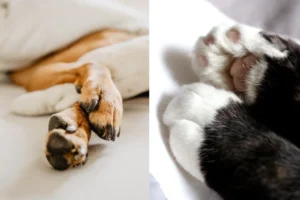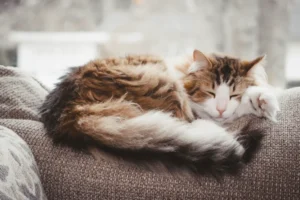Cats are known for their incredible agility and grace. But have you ever wondered why cats are so agile?
Cats are agile due to a combination of factors, including their flexible bodies, powerful muscles, keen senses, and specialized skeletal structure. Let’s explore the reasons behind their impressive agility.
Evolutionary Adaptations
Cats’ agility can be traced back to their evolutionary history. As natural hunters, cats needed to be agile to catch prey and avoid predators. Over time, they developed specialized muscles, bones, and reflexes that contribute to their incredible agility. In the wild, agility meant survival, so cats with superior agility were more likely to thrive and pass on their genes. This process of natural selection favored cats with exceptional agility, leading to the agile felines we know today.
Flexibility and Range of Motion
Cats’ flexible spines and joints play a crucial role in their agility. Unlike humans, cats have an extraordinary range of motion in their spine, allowing them to twist, turn, and contort their bodies with ease. This flexibility enables cats to land on their feet after falls and to navigate even the narrowest spaces effortlessly. Additionally, their powerful leg muscles provide them with the explosive strength needed for quick sprints and high jumps.
- Muscle Structure: Cats have fast-twitch muscle fibers that contribute to their agility. These fibers enable rapid movements and quick reflexes, essential for hunting and capturing prey.
- Tail Balance: Cats use their tails as a counterbalance while jumping and climbing, enhancing their agility and coordination.
- Low Body Fat: Cats have low body fat percentages, which reduce resistance and allow for swift movements without being weighed down.
By combining these physical attributes with their instinctual hunting behaviors, cats have become unparalleled masters of agility in the animal kingdom.
Muscle Strength and Power
Cats are incredibly agile due to their strong muscles and quick reflexes. Their muscles are packed with fast-twitch fibers, allowing for rapid and powerful movements. These muscles provide the necessary strength to leap great distances and heights with ease. Additionally, cats have a flexible spine that helps them twist and turn effortlessly, further enhancing their agility. Their powerful legs enable them to run at high speeds and make quick directional changes, showcasing their incredible muscle strength and power.
Senses and Coordination
Cats’ sharp senses and exceptional hand-eye coordination play a crucial role in their agility. Their keen eyesight allows them to spot even the smallest movement, helping them react swiftly to changes in their environment. Furthermore, cats possess excellent hearing and a highly developed sense of smell, which aids in their ability to navigate with precision. Combine these heightened senses with their impressive coordination, and you have a feline companion that moves with grace and agility.
Additional Unique Insight:
- Cats have specialized whiskers that are incredibly sensitive to touch, providing them with valuable information about their surroundings. These whiskers help cats gauge the size of openings and navigate tight spaces with ease.
By leveraging their muscle strength, senses, and coordination, cats exhibit unmatched agility, making them adept hunters and playful companions alike.
Balance and Reflexes
Cats are incredibly agile due to their exceptional balance and lightning-fast reflexes. Their keen sense of balance allows them to maneuver effortlessly, whether leaping from high places or walking along narrow surfaces. Cats’ reflexes are honed to pinpoint accuracy, enabling them to react quickly to any sudden movement or change in their environment. This combination of acute balance and lightning reflexes grants cats the ability to navigate various terrains with grace and precision.
Hunting Instincts
Cats’ natural hunting instincts play a significant role in their agility. From a young age, cats exhibit a strong drive to hunt and capture prey. This innate instinct pushes them to be agile and swift, mimicking the movements necessary to catch prey in the wild. Their hunting instincts drive them to pounce, chase, and leap with extraordinary speed and accuracy, enhancing their overall agility. This primal urge to hunt not only benefits their survival but also contributes to their remarkable agility and nimbleness.
- Stalking: Cats are skilled at stalking their prey, moving silently and patiently before making a sudden, swift attack.
- Pouncing: With lightning speed and precision, cats can pounce on their prey from a distance, utilizing their agility to launch surprise attacks.
- Climbing: Cats’ agility extends to climbing trees, fences, and other structures effortlessly, showcasing their ability to navigate various environments with ease.
Remember, a cat’s agility is not just a show of physical prowess but a reflection of their instinctual behaviors deeply ingrained in their DNA.
Cat Breeds and Variations
When it comes to agility, different cat breeds boast varying levels of prowess based on their unique physical characteristics and behaviors. Abyssinians are known for their high energy levels and superb jumping abilities, making them agile climbers and acrobats. Oriental breeds are sleek and muscular, excelling in activities that require speed and agility. Siamese cats are nimble and graceful, with a natural athleticism that allows them to navigate obstacles with ease. On the other hand, British Shorthairs are more laid-back and less agile compared to their more active counterparts. By understanding the distinct traits of each breed, we can appreciate how their individual characteristics influence their agility levels.
Fun Facts about Cats
Did you know that a cat’s spine is incredibly flexible, consisting of up to 53 vertebrae compared to a human’s 34? This gives them remarkable agility and the ability to twist and turn their bodies in ways that seem impossible. Cats also have a unique collarbone that allows them to fit through tight spaces, showcasing their incredible flexibility. Additionally, their keen sense of balance and coordination contributes to their agility, enabling them to execute precise movements with grace and precision. Next time you witness your feline friend effortlessly leaping and climbing, remember it’s not just luck – it’s their impressive physical attributes at play!
By understanding the unique combination of physical attributes and behaviors that make cats so agile, we can truly appreciate and admire the grace and prowess of these fascinating felines.
Alex, a passionate animal lover, has experience in training and understanding animal behavior. As a proud pet parent to two dogs and three cats, he founded AnimalReport.net to share insights from animal experts and expand his knowledge of the animal kingdom.









